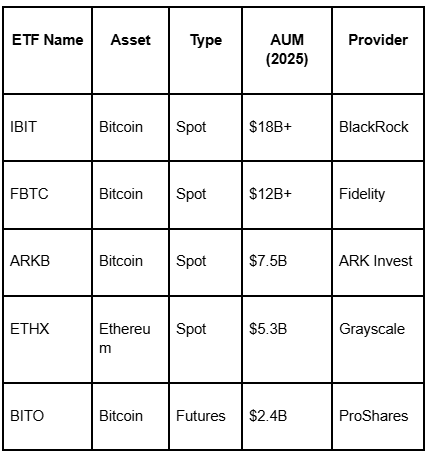What Is an ETF in Crypto? A Complete Guide for Crypto Investors in 2025
.png)
The world of crypto investing is expanding at lightning speed. With growing institutional adoption and mainstream interest, new financial instruments are emerging to make crypto more accessible to everyday investors. One of the most impactful of these tools is the Exchange-Traded Fund (ETF) — and in 2025, crypto ETFs are playing a crucial role in shaping the future of digital asset investing.
📊 What Is an ETF?
An ETF (Exchange-Traded Fund) is a type of investment fund traded on traditional stock exchanges, just like individual stocks. ETFs hold a basket of assets such as stocks, bonds, commodities—or, in this case, cryptocurrencies.
When you buy shares of an ETF, you’re investing in a diversified portfolio managed by an institution. Instead of buying each asset individually, ETFs let you gain exposure to a group of assets through a single security.
🪙 What Is a Crypto ETF?
A crypto ETF is a special type of ETF that tracks the price of one or more cryptocurrencies, such as Bitcoin, Ethereum, or a basket of altcoins. These ETFs allow investors to gain exposure to crypto markets without needing to buy, store, or manage digital assets directly.
Crypto ETFs are listed on traditional financial exchanges (like Nasdaq or NYSE) and can be purchased via brokerage accounts—making them ideal for both institutional investors and crypto-curious retail traders.
🔍 Types of Crypto ETFs
There are two main categories of crypto ETFs:
1. Spot Crypto ETFs
- Directly hold the underlying cryptocurrency (e.g., Bitcoin, Ethereum).
- Track the real-time price of the asset.
- Considered the most accurate and direct method of gaining crypto exposure.
- Example: BlackRock’s iShares Bitcoin Trust.
2. Futures-Based Crypto ETFs
- Do not hold actual cryptocurrency.
- Invest in futures contracts that speculate on the asset’s future price.
- Prone to “tracking errors” and additional management fees.
- Example: ProShares Bitcoin Strategy ETF (BITO).
In 2025, spot ETFs have become more popular, especially after multiple approvals in major markets like the U.S., Canada, and Hong Kong.
✅ Benefits of Crypto ETFs
Crypto ETFs offer a range of advantages for investors seeking exposure to digital assets without managing crypto wallets or private keys.
1. Accessibility
- Trade crypto exposure from a traditional brokerage account.
- No need for crypto exchanges, wallets, or DeFi protocols.
2. Regulation and Security
- Managed by licensed institutions and regulated by bodies like the SEC.
- Custody solutions are handled by professionals (e.g., Coinbase Custody, Fidelity Digital).
3. Diversification
- Some ETFs offer exposure to a basket of cryptocurrencies, reducing risk.
- Others may focus on specific sectors like DeFi or metaverse tokens.
4. Tax and Retirement Account Eligibility
- Can be included in IRAs, 401(k)s, and tax-advantaged portfolios in some jurisdictions.
⚠️ Risks of Crypto ETFs
While crypto ETFs simplify access, they are not risk-free.
1. Management Fees
- ETFs charge annual fees (0.20%–1.00%), which can affect long-term gains.
2. Lack of Full Ownership
- You don’t hold the actual coins, so you can’t use them for staking, yield farming, or DeFi.
3. Volatility
- Crypto markets are still highly volatile. ETF prices can fluctuate rapidly.
4. Tracking Errors (Futures ETFs)
- Futures-based ETFs often lag behind the spot price of the cryptocurrency.
💡 Why Crypto ETFs Matter in 2025
The launch and adoption of crypto ETFs signal mainstream validation of the crypto market.
- Over $60 billion has poured into Bitcoin and Ethereum ETFs since early 2024.
- Institutional players like BlackRock, Fidelity, and ARK Invest are leading issuers.
- Spot Bitcoin ETFs helped propel BTC above $118,000 in July 2025.
- Regulatory green lights from the SEC, MAS, and other regulators mark a shift in global crypto policy.
Crypto ETFs reduce barriers to entry and give traditional investors a safe, regulated way to participate in the digital economy.
🤖 How Token Metrics Helps You Analyze Crypto ETF Trends
As ETFs drive price action, tools like Token Metrics give you an edge by turning market noise into actionable intelligence.
🔹 Real-Time Bullish/Bearish Signals
Token Metrics' AI algorithm scans exchange inflows, ETF data, and sentiment to issue buy/sell signals for major cryptocurrencies like Bitcoin, Ethereum, XRP, and more.

🔹 Institutional Flow Tracking
Track ETF fund flows to understand where institutions are allocating capital—key for timing your own entries and exits.
🔹 Price Predictions and Trend Grades
AI-generated price predictions, trader grades, and investor scores help you assess risk before investing in ETF-driven rallies.

🔹 Portfolio Tracking
Token Metrics syncs with your wallet or brokerage to track crypto ETF exposure alongside your on-chain tokens.
By using Token Metrics, you’re not just following ETF trends—you’re staying ahead of them.
🔄 Popular Crypto ETFs in 2025
Here are some of the top-performing crypto ETFs currently available:

These ETFs are helping investors tap into the gains of crypto markets—without the complexity.
🧠 Final Thoughts
Crypto ETFs represent a pivotal shift in how digital assets are being embraced in traditional finance. They offer accessibility, regulatory clarity, and simplified crypto exposure for everyone from hedge funds to retail investors.
But smart investing goes beyond headlines. Platforms like Token Metrics help you:
- Time entries and exits with AI-powered signals
- Track ETF fund flows to gauge institutional momentum
- Build conviction using on-chain data and predictive analytics
In 2025 and beyond, the winning strategy is clear: combine the safety of ETFs with the intelligence of Token Metrics.
Create Your Free Token Metrics Account

.png)




%201.svg)
%201.svg)


%201.svg)















.svg)




.png)